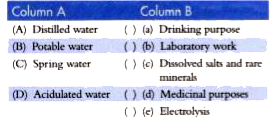Complete Solutions to ASSESMENT TEST (TEST 2 (SELECT THE CORRECT ALTERNATIVE FROM THE GIVEN CHOICES)) of chapter Water of Class 7 book with complete answers and questions
| Class 7 | CHEMISTRY |
| Chapter | WATER |
| PEARSON IIT JEE FOUNDATION | ASSESMENT TEST (TEST 2 (SELECT THE CORRECT ALTERNATIVE FROM THE GIVEN CHOICES)) |
| Number Of Questions | 15 |
| Academic Year | 2023-24 |
Which of the following salts is responsible for temporary and permanent hardness of water, respectively?
View SolutionWhich of the following is a biodegradable substance?
View SolutionMatch the following:

View SolutionThe amount of heat energy required to increase the temperature of X g of water by `10^(@)C` is found to be 15 cal. Calculate X.
View SolutionArrange the steps in a sequence for the conversion of atmospheric water vapour into underground water.
(1) infiltration in recharge area
(2) water table
(3) infiltration in zone of aeration
(4) precipitation
(5) Aquifer
View SolutionWater-containing salt X, of a divalent metal, when treated with a compound Y gives much lather with soap. Further, an insoluble compound `MgCO_(3)` and salt of a monovalent metal sulphate are formed. Identify X and Y, respectively.
View SolutionArrange the steps in a sequence for the removal of microorganisms during the purification of drinking water.
(1) lime feeder
(2) mechanical mixing
(3) alum feeder
(4) sedimentation tank
(5) passing through gravel and sand
(6) chlorine feeder
View SolutionWhat is the latent heat of fusion and latent heat of vaporisation of 10 g of ice and water, respectively?
View SolutionWhich of the following types of water does not contain dissolved gases such as oxygen and carbon dioxide?
View SolutionThe volumetric composition of water is
View SolutionThe solvent water is used in car radiators. Which of the following properties of water is exploited?
View SolutionAssertion (A): The Clark's method involves removal of permanent hardness.
Reason ( R): The Clark's method involves the addition of slaked lime which results in the removal of bicarbonates as insoluble carbonates.
View SolutionWhich among the following is based on the principle that boiling point decreases with decrease in atmospheric pressure?
View SolutionAssertion (A): The products of electrolysis of water are hydrogen and oxygen.
Reason ( R): In electrolysis process of water, hydrogen ions are attracted to anode and hydroxyl ions are attracted to cathode.
View SolutionWhen the temperature of water rises from `0^(@)C` to `10^(@)C`, the density of water
View Solution
ASSESMENT TEST (TEST 2 (SELECT THE CORRECT ALTERNATIVE FROM THE GIVEN CHOICES)) questions and complete solutions for chapter Water of PEARSON IIT JEE FOUNDATION of Class 7
All Exercises from PEARSON IIT JEE FOUNDATION Class 7 CHEMISTRY WATER
- ASSESMENT TEST (TEST 1 (SELECT THE CORRECT ALTERNATIVE FROM THE GIVEN CHOICES))
- ASSESMENT TEST (TEST 2 (SELECT THE CORRECT ALTERNATIVE FROM THE GIVEN CHOICES))
- Assessment Test 1
- Assessment Test 10
- Assessment Test 11
- Assessment Test 12
- Assessment Test 13
- Assessment Test 14
- Assessment Test 15
- Assessment Test 16
- Assessment Test 2
- Assessment Test 3
- Assessment Test 4
- Assessment Test 5
- Assessment Test 6
- Assessment Test 7
- Assessment Test 8
- Assessment Test 9
- CONCEPT APPLICATION (LEVEL 1 ( SELECT THE CORRECT ALTERNATIVE.))
- CONCEPT APPLICATION (LEVEL 1 (FILL IN THE BLANKS))
- CONCEPT APPLICATION (LEVEL 1 (MATCH THE COLUMN))
- CONCEPT APPLICATION (LEVEL 1 (TRUE OR FALSE))
- CONCEPT APPLICATION (LEVEL 2 ( SELECT THE CORRECT ALTERNATIVE))
- CONCEPT APPLICATION (LEVEL 2 )
- CONCEPT APPLICATION (LEVEL 3)
- Essay Type Questions
- EXAMPLE
- Level 2
- Level 3
- Level-1
- Short-Answer Type Questions
- Test Your Concepts
- TEST YOUR CONCEPTS (ESSAY TYPE QUESTIONS)
- TEST YOUR CONCEPTS (FILL IN THE BLANKS)
- TEST YOUR CONCEPTS (FOR EACH OF THE QUESTIONS, FOUR CHOICES HAVE BEEN PROVIDED. SELECT THE CORRECT ALTERNATIVE.)
- TEST YOUR CONCEPTS (MATCH THE COLUMN A AND COLUMN B)
- TEST YOUR CONCEPTS (SHORT ANSWER TYPE QUESTIONS)
- TEST YOUR CONCEPTS (VERY SHORT ANSWER TYPE QUESTIONS)
- Very Short-Answer Type Questions